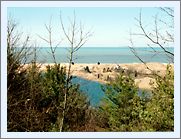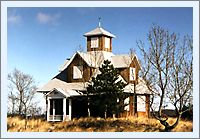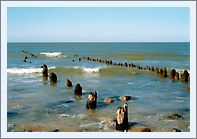|
Historical
Information

Home to the Pottawatomie
tribe in the early part of the nineteenth century, the Kalamazoo River
wound its way among the scrub covered dunes before entering Lake
Michigan some seven miles to the south of Lake Macatawa and nineteen
miles to the north of the Black
River. William G. Butler and his family
became the first white settlers to enter the area when they and all
their worldly goods were lowered to a small boat from the deck of the
schooner MADISON, and rowed to shore in 1830. After living at the river
mouth for some time, Butler loaded his family onto a log raft and made
his way a couple of miles upstream to set up a homestead on a flat area
at the edge of a widening in the river.
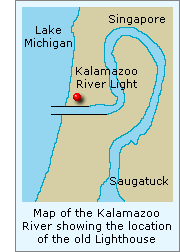 Envisioning a growing community in the
area around his homestead, Butler platted the village that would
eventually become known as Saugatuck on July 17, 1834. Within a few
years a number of other settlers began moving in, setting up their own
homesteads and businesses. A sawmill was established at the northernmost
meander of the river about a mile from Saugatuck and three-quarters of a
mile from the river mouth, and a separate community known as Singapore
sprang up to support the mill. To provide assistance to vessels seeking
entry into the river, local business interests banded together to
establish a private light at the river mouth. Envisioning a growing community in the
area around his homestead, Butler platted the village that would
eventually become known as Saugatuck on July 17, 1834. Within a few
years a number of other settlers began moving in, setting up their own
homesteads and businesses. A sawmill was established at the northernmost
meander of the river about a mile from Saugatuck and three-quarters of a
mile from the river mouth, and a separate community known as Singapore
sprang up to support the mill. To provide assistance to vessels seeking
entry into the river, local business interests banded together to
establish a private light at the river mouth.
With the establishment of the first
school between Singapore and Saugatuck in 1836, Saugatuck was fast
becoming the thriving community that Butler had envisioned. Lumbering
and commercial activity gradually increased, and the Kalamazoo River
became busy with outbound log rafts and inbound vessels bringing
supplies to the growing communities upriver. Reacting to this increase
in maritime traffic, on January 25, 1836 Senator Linn presented a
petition before Congress on behalf of concerned maritime interests in
Detroit praying for harbor improvements and the construction of a
government lighthouse at the entrance to the Kalamazoo river.
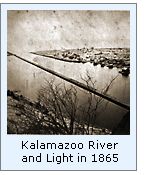 Congress responded with an
appropriation of five thousand dollars for the construction of the
lighthouse on February 1, 1837. After the purchase of land to the north
of the river mouth from Horace M. Comstock on March 5, 1838 for the sum
of $250, a contract for the station's construction was awarded with the
stipulation that it be completed by October 15, 1838. However, during
his visit to the site on September 5thof that year, Lieutenant James T.
Homans reported that the contractor had made no progress beyond the
collection of a pile of stones for the building's foundation. While it
was normal practice at that time for the Collector of Customs of the
area to superintend such lighthouse construction projects, this had not
been the case at Kalamazoo River, and as a result the contractor had
been working without supervision to obvious deleterious results. Homans
appointed a special agent to superintend the construction, under whose
supervision the structure was completed the following year. The 30 foot
tall structure was constructed of rubble stone and was situated 75 feet
from the Lake Michigan shoreline at a point 14 feet above lake level. As
was the case with most lights built during the period, the tower was
capped with a birdcage-style lantern, housing an array of eleven Lewis
lamps with fourteen-inch reflectors. Payroll records for the station
indicate that keeper Stephen Nichols reported to his assignment on
November 11th, and it is thus likely that the Kalamazoo River Light was
exhibited for the first time late in the 1839 navigation season. Congress responded with an
appropriation of five thousand dollars for the construction of the
lighthouse on February 1, 1837. After the purchase of land to the north
of the river mouth from Horace M. Comstock on March 5, 1838 for the sum
of $250, a contract for the station's construction was awarded with the
stipulation that it be completed by October 15, 1838. However, during
his visit to the site on September 5thof that year, Lieutenant James T.
Homans reported that the contractor had made no progress beyond the
collection of a pile of stones for the building's foundation. While it
was normal practice at that time for the Collector of Customs of the
area to superintend such lighthouse construction projects, this had not
been the case at Kalamazoo River, and as a result the contractor had
been working without supervision to obvious deleterious results. Homans
appointed a special agent to superintend the construction, under whose
supervision the structure was completed the following year. The 30 foot
tall structure was constructed of rubble stone and was situated 75 feet
from the Lake Michigan shoreline at a point 14 feet above lake level. As
was the case with most lights built during the period, the tower was
capped with a birdcage-style lantern, housing an array of eleven Lewis
lamps with fourteen-inch reflectors. Payroll records for the station
indicate that keeper Stephen Nichols reported to his assignment on
November 11th, and it is thus likely that the Kalamazoo River Light was
exhibited for the first time late in the 1839 navigation season.
As the small amount of timber around
the river mouth was cut down, the fragile natural cover on the sand
dunes disappeared, and the dunes began to shift. This drifting began to
cause problems at the river mouth where sand frequently drifted across
the channel, requiring that it be removed to allow vessels with any
significant draft to gain entry. The drifting and blowing sand was also
evidently causing problems at the lighthouse in 1850 when Henry B.
Miller, the Inspector of Lights reported that the area on which the
station was built was wearing away quickly and the tower was in need of
whitewashing as a result of virtually constant sand-blasting. Concerned
that the erosion might undermine the integrity of the tower, Miller had
a timber protection constructed to help stem the erosion around the
building's foundation.
With the formation of the Lighthouse
Board in 1853, a plan was put in place to replace all of the Lewis lamps
in the system with the vastly superior French Fresnel lenses. As part of
this upgrade, a fixed white Sixth Order Fresnel lens was installed in
the Kalamazoo River light in 1856. Unabated, the problem with shifting
sands and erosion at the river mouth became a matter of such concern
that Senator Chandler presented a resolution on behalf of the Michigan
Legislature requesting Federal funds for improving the harbor on
February 11, 1858. Unfortunately, action was not taken quickly enough,
and the Kalamazoo River Light toppled from its foundation that same
year.
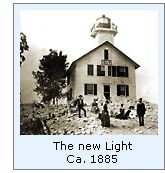 A work crew was dispatched to the
Kalamazoo River, and in an attempt to avoid the drifting and undermining
problems of the previous location, a site was chosen atop the dune 150
feet to the northeast of the site of the old light. By virtue of its
construction on sand, the new station was built on a foundation of three
hand-hewn 10" by 10" timbers which were bolted to the upper
end of nine 8-inch diameter cast iron pipe pilings driven into the sand
and encased in concrete and stone, and in an attempt to help stave-off
future erosion, the face of the dune was reinforced with slabs of
limestone barged-in from Alpena. The main structure was built to the
same plan as that used at Cheboygan the year before, and consisted of a
white painted two and a half story wooden frame structure with 8-inch
thick walls throughout, standing 25 foot by 40 foot in plan, topped by a
7 foot 9-inch square tower at the south gable end, extending fifteen
feet above the roof. The tower was capped with a gallery on which was
centered an octagonal cast iron lantern into which a new Fifth Order
Fresnel lens was installed. The tower stood 33 feet from its foundation
to the center of the lamp, providing the station with a focal plane of
45 feet above the surface of the lake. With the construction of a well
and a barn for the keepers horse, work was completed at the new station,
and the light was exhibited for the first time on an as yet undetermined
date in 1859. A work crew was dispatched to the
Kalamazoo River, and in an attempt to avoid the drifting and undermining
problems of the previous location, a site was chosen atop the dune 150
feet to the northeast of the site of the old light. By virtue of its
construction on sand, the new station was built on a foundation of three
hand-hewn 10" by 10" timbers which were bolted to the upper
end of nine 8-inch diameter cast iron pipe pilings driven into the sand
and encased in concrete and stone, and in an attempt to help stave-off
future erosion, the face of the dune was reinforced with slabs of
limestone barged-in from Alpena. The main structure was built to the
same plan as that used at Cheboygan the year before, and consisted of a
white painted two and a half story wooden frame structure with 8-inch
thick walls throughout, standing 25 foot by 40 foot in plan, topped by a
7 foot 9-inch square tower at the south gable end, extending fifteen
feet above the roof. The tower was capped with a gallery on which was
centered an octagonal cast iron lantern into which a new Fifth Order
Fresnel lens was installed. The tower stood 33 feet from its foundation
to the center of the lamp, providing the station with a focal plane of
45 feet above the surface of the lake. With the construction of a well
and a barn for the keepers horse, work was completed at the new station,
and the light was exhibited for the first time on an as yet undetermined
date in 1859.
While local business interests
constructed timber crib protections in an attempt to limit the effects
of drifting sand at the mouth of the river, Congress ignored frequent
pleas for Federal assistance to improve the river entrance. Finally, in
1869 Congress appropriated $30,000 for improvements at the Kalamazoo
River, and the War Department Engineers arrived to begin reconstruction.
A pair of timber crib protective piers filled with stone were
constructed on each side of the river mouth, which was widened to 225
feet, and the north pier was extended upriver an additional 450 feet to
provide protection for the dune on which the lighthouse was located. The
south pier revetments extended up the river almost three quarters of a
mile in order to maintain the navigable channel.
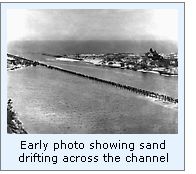 Congress appropriated an additional
$10,000 for harbor improvements at the river entrance in 1873, at which
time the piers were reinforced, and the North pier extended to a length
of 310 feet and the south pier to 225 feet in length. With the 1859
light now located some distance behind the piers, it was determined that
a light on one of the piers would better serve mariners seeking entry
into the river, and in 1876 the Fresnel lens was removed from the old
light and placed atop a white timber skeleton pierhead light at the end
of the south pier. Standing 27 feet tall, the new pierhead light had a
focal plane of 34 feet and was visible for a distance of 11½ miles at
sea. While the old light no longer functioned as an aid to navigation,
it continued to serve as the dwelling for keeper Samuel Underwood, who
was now forced to row across the river a number of times each day to
tend the new light. Congress appropriated an additional
$10,000 for harbor improvements at the river entrance in 1873, at which
time the piers were reinforced, and the North pier extended to a length
of 310 feet and the south pier to 225 feet in length. With the 1859
light now located some distance behind the piers, it was determined that
a light on one of the piers would better serve mariners seeking entry
into the river, and in 1876 the Fresnel lens was removed from the old
light and placed atop a white timber skeleton pierhead light at the end
of the south pier. Standing 27 feet tall, the new pierhead light had a
focal plane of 34 feet and was visible for a distance of 11½ miles at
sea. While the old light no longer functioned as an aid to navigation,
it continued to serve as the dwelling for keeper Samuel Underwood, who
was now forced to row across the river a number of times each day to
tend the new light.
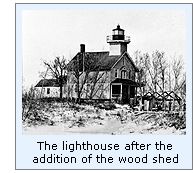 1883 saw the excavation of a 15-foot by
13½ -foot cellar beneath the keepers dwelling and the installation of
an underground cistern, located approximately 10 feet northwest of the
building. Downspouts attached to the gutters diverted rainwater from the
roof into the cistern to serve as a back-up water supply for the
dwelling. Wainscoting was installed around the building's foundation and
a wood shed and hand pump-operated drive well were added. Erosion in the
area of the keepers dwelling continued to cause concern in 1885, when
the dune was faced with logs to help stem the erosion. Three years
later, iron boat davits were installed at the pierhead light in order to
allow the keeper to lift the boat out of the water when servicing the
light. 1883 saw the excavation of a 15-foot by
13½ -foot cellar beneath the keepers dwelling and the installation of
an underground cistern, located approximately 10 feet northwest of the
building. Downspouts attached to the gutters diverted rainwater from the
roof into the cistern to serve as a back-up water supply for the
dwelling. Wainscoting was installed around the building's foundation and
a wood shed and hand pump-operated drive well were added. Erosion in the
area of the keepers dwelling continued to cause concern in 1885, when
the dune was faced with logs to help stem the erosion. Three years
later, iron boat davits were installed at the pierhead light in order to
allow the keeper to lift the boat out of the water when servicing the
light.
While making her way into the river in
1892, the steamer CHARLES MCVEA smashed head-on into the pierhead light.
The damage resulting was so severe that the light was considered
irreparably damaged, and the lens was returned to the lantern atop the
keepers dwelling and re-exhibited in its old home on the night of August
16. All salvageable materials from the pierhead light were removed and
carried across the river for storage in the station barn.
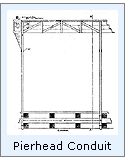 In the early 1890's, District Engineer
Major Milton B. Adams was experimenting with a "conduit"
system at a number of pierhead lights around Lake Michigan. Consisting
of a square wooden tube known as a conduit which extended along the pier
supported by trestles similar to those used to support elevated walks,
the conduit contained iron tracks on which a small wheeled cart holding
the lens was mounted. Connected by cable to pulleys at each end, it was
designed to allow the keepers to conduct all lens service close to
shore, then transporting the lens along the conduit to the end of the
pier where it was displayed from within a box with glass sides and a
galvanized iron roof. A 240 long conduit system was installed at the end
of an elevated walk on the south pier at Kalamazoo River in 1894, with
its fixed red lens lantern exhibited for the first time on the night of
May 23. However, with the exhibition of this new light, the old 1859
light was not extinguished, but continued to serve as a coast light. In the early 1890's, District Engineer
Major Milton B. Adams was experimenting with a "conduit"
system at a number of pierhead lights around Lake Michigan. Consisting
of a square wooden tube known as a conduit which extended along the pier
supported by trestles similar to those used to support elevated walks,
the conduit contained iron tracks on which a small wheeled cart holding
the lens was mounted. Connected by cable to pulleys at each end, it was
designed to allow the keepers to conduct all lens service close to
shore, then transporting the lens along the conduit to the end of the
pier where it was displayed from within a box with glass sides and a
galvanized iron roof. A 240 long conduit system was installed at the end
of an elevated walk on the south pier at Kalamazoo River in 1894, with
its fixed red lens lantern exhibited for the first time on the night of
May 23. However, with the exhibition of this new light, the old 1859
light was not extinguished, but continued to serve as a coast light.
1899 saw some welcome repairs and
additions at the main light. The structure was completely resided with
cut cedar shingles and a platform was constructed at the kitchen door. A
wooden walkway was built from this new platform to the verandah at the
front of the building, and a boathouse was constructed at the river
bank. A landing pier was built in front of the boathouse, and a 174 foot
long wooden walkway with hand rail was constructed from the boat landing
to the verandah.
While the conduit lights were heralded
by the District Engineer as being a major improvement when they were
first installed, in practice they proved to be less than reliable, and
were all subsequently dismantled. The Kalamazoo south pier conduit was
removed in 1900, and the light exhibited from a post located 152 feet
from the end of an elevated walk at a focal plane of 21 feet 6 inches.
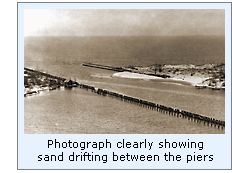 Drifting sand continued to plague the
river entrance at the dawn of the new century, and photographs taken at
the time frequently show sand drifting across the river from the
northern shore. After considerable contemplation it was decided that
rather than trying to keep the present river entrance sand free, it
would make greater sense to dig a new connecting channel between the
lake and the river approximately a mile further north along the lake
shore in the Singapore area. There were a number of reasons why this new
entrance was considered to be the optimal solution; The shore in that
area was considerably less susceptible to drifting, and thus the new
river entry could be maintained without the frequent digging and
dredging required of the old opening. An entry in the new location would
remove a major bend in the river, facilitating navigation to larger
vessels. The current was faster at this pint in the river, and would
thus help flush the silt and drifting sand into the lake. Finally, the
distance between the river entry and the towns upstream would be reduced
by over a mile, significantly reducing the time it would take to enter
or leave the upriver harbors after loading and unloading. Drifting sand continued to plague the
river entrance at the dawn of the new century, and photographs taken at
the time frequently show sand drifting across the river from the
northern shore. After considerable contemplation it was decided that
rather than trying to keep the present river entrance sand free, it
would make greater sense to dig a new connecting channel between the
lake and the river approximately a mile further north along the lake
shore in the Singapore area. There were a number of reasons why this new
entrance was considered to be the optimal solution; The shore in that
area was considerably less susceptible to drifting, and thus the new
river entry could be maintained without the frequent digging and
dredging required of the old opening. An entry in the new location would
remove a major bend in the river, facilitating navigation to larger
vessels. The current was faster at this pint in the river, and would
thus help flush the silt and drifting sand into the lake. Finally, the
distance between the river entry and the towns upstream would be reduced
by over a mile, significantly reducing the time it would take to enter
or leave the upriver harbors after loading and unloading.
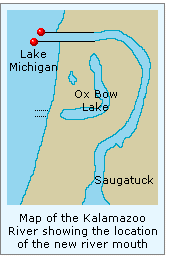 Work on excavating the new channel
began in 1904, along with the construction of protective revetments on
each side of the opening and a pair of piers protruding into the lake to
help still the waters within the channel. On the completion of the new
channel in 1906, a simple post lamp with a platform for working on the
lens lantern was erected on the outer end of the new south pier, and
keeper George Baker who had been appointed to replace Samuel Underwood
after he was removed from the position in 1878, assumed responsibility
for both the new pierhead light and the old 1859 light, which now served
purely as a coast light, since it was located a mile south of the new
river entrance. To differentiate between the two lights, the pierhead
light at the new opening was officially named the Saugatuck Harbor South
Pierhead Light, while the old light continued to be known as the
Kalamazoo River Light. Work on excavating the new channel
began in 1904, along with the construction of protective revetments on
each side of the opening and a pair of piers protruding into the lake to
help still the waters within the channel. On the completion of the new
channel in 1906, a simple post lamp with a platform for working on the
lens lantern was erected on the outer end of the new south pier, and
keeper George Baker who had been appointed to replace Samuel Underwood
after he was removed from the position in 1878, assumed responsibility
for both the new pierhead light and the old 1859 light, which now served
purely as a coast light, since it was located a mile south of the new
river entrance. To differentiate between the two lights, the pierhead
light at the new opening was officially named the Saugatuck Harbor South
Pierhead Light, while the old light continued to be known as the
Kalamazoo River Light.
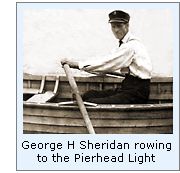 By 1909, without continued dredging,
the drifting sands completely filled the abandoned river entrance to the
south and people were able to walk directly between the piers where only
a few years previous large steamers had made their way in an out of the
river. 1909 was also an important year in the history of the Kalamazoo
Light as keeper George Baker retired after tending the light for 31
years. Baker was replaced by George Sheridan, who was transferred-in
after four years as First Assistant Keeper at the Michigan City Pierhead
Light. Sheridan was the first professional keeper to be assigned to the
Kalamazoo Light, all of those before him having been appointed directly
into their positions without prior lighthouse service and leaving the
service after their time at Kalamazoo. By 1909, without continued dredging,
the drifting sands completely filled the abandoned river entrance to the
south and people were able to walk directly between the piers where only
a few years previous large steamers had made their way in an out of the
river. 1909 was also an important year in the history of the Kalamazoo
Light as keeper George Baker retired after tending the light for 31
years. Baker was replaced by George Sheridan, who was transferred-in
after four years as First Assistant Keeper at the Michigan City Pierhead
Light. Sheridan was the first professional keeper to be assigned to the
Kalamazoo Light, all of those before him having been appointed directly
into their positions without prior lighthouse service and leaving the
service after their time at Kalamazoo.
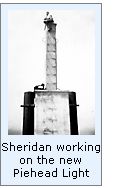 Also in 1909, a concrete foundation was
poured on Saugatuck Harbor south entrance pier, and a square cast iron
pedestal and column, painted bright red to enhance their visibility were
installed atop the pedestal. The lower pedestal contained acetylene
storage tanks which supplied a 300 mm lens-lantern atop the 26 foot tall
structure. Equipped with an automatic sun valve, the light was designed
to operate for months without refilling or attendance, and its flashing
red 35-candlepower, emitting a single flash every three seconds, was
visible for a distance of 7 miles. Also in 1909, a concrete foundation was
poured on Saugatuck Harbor south entrance pier, and a square cast iron
pedestal and column, painted bright red to enhance their visibility were
installed atop the pedestal. The lower pedestal contained acetylene
storage tanks which supplied a 300 mm lens-lantern atop the 26 foot tall
structure. Equipped with an automatic sun valve, the light was designed
to operate for months without refilling or attendance, and its flashing
red 35-candlepower, emitting a single flash every three seconds, was
visible for a distance of 7 miles.
With the establishment of a flashing
white light on the Saugatuck Harbor north pier in 1914, the new river
entrance was completely illuminated, and the old 1859 light was
considered obsolete. George Sheridan exhibited the light of the
Kalamazoo River Light for the last time on the night of October 16, and
left to his new assignment at St. Joseph.
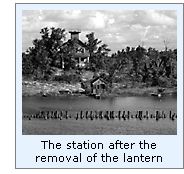 No longer serving any purpose, the
Lighthouse Service removed the lantern from atop the tower, and for the
next twenty years leased the old station buildings to Frederick F.
Fursman, the director of the famous Oxbow Summer School of Art, for the
sum of $10.00 a month. Only occupied during the summer months, the old
building began to suffer from vandalism and a lack of constant
maintenance. The building was offered-up for sale by closed mail bid in
1936, with the single bid received from Arthur F Deam, an architect and
a close friend of Fursman. The Deams took title to the building by
quitclaim deed on July 19, 1937, and over the following years used the
old building as a family summer cottage, undertaking an extensive
restoration of the station buildings and property. No longer serving any purpose, the
Lighthouse Service removed the lantern from atop the tower, and for the
next twenty years leased the old station buildings to Frederick F.
Fursman, the director of the famous Oxbow Summer School of Art, for the
sum of $10.00 a month. Only occupied during the summer months, the old
building began to suffer from vandalism and a lack of constant
maintenance. The building was offered-up for sale by closed mail bid in
1936, with the single bid received from Arthur F Deam, an architect and
a close friend of Fursman. The Deams took title to the building by
quitclaim deed on July 19, 1937, and over the following years used the
old building as a family summer cottage, undertaking an extensive
restoration of the station buildings and property.
The Kalamazoo Harbor South Pierhead
Light was electrified in the early 1950's and its output increased to
140 candlepower, also increasing its visible range to a distance of ten
miles. The light was also equipped with an electrically-operated
diaphragm fog signal, which emitted a two-second grunt every 15 seconds.
After years of loving restoration by
the Deam family, the old Kalamazoo Light station was obliterated by a
tornado on April 3 1956, leaving nothing intact beyond the cellar that
was dug beneath the lighthouse in 1883. The Deams managed to salvage a
number of articles from the old lighthouse, including porch railings,
six-paneled doors, some newel posts, one of the 10-inch by 10-inch beams
which had served as the main foundation for the old structure, and the
pediment displaying the construction date "1859" which was
displayed above the second floor windows of the old structure. Art Deam,
who had taken over as President of the Oxbow School on Fursman's death,
then set about designing a "lighthouse-style" summer home for
his family. In so doing, he carefully incorporated all of the salvaged
remnants of the beloved old structure into his new design, including the
"1859" pediment, which he proudly incorporated into the porch
above the front door entry.
Over the years since the new river
entrance had been cut, the stretch of river between the two river
entrances has become completely land-locked, with the section of river
becoming known as the Ox Bow lake. Almost one hundred years after the
old river entrance drifted shut, remnants of its original function can
still be seen. Two rows of pilings which once formed the revetments on
the north and south banks of the river still protrude above the surface
of Ox Bow lake, and the skeletal remains of the old piers can be seen
leading out towards the setting sun across Lake Michigan.
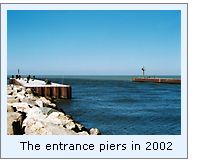 Late in the twentieth century, both
North and South Saugatuck Harbor Pierhead lights were replaced by white
"D9" cylindrical towers outfitted with modern acrylic optics.
The North Pierhead light displaying a horizontal black band across its
middle section, and the South Pierhead light showing a similar band of
red. The South Pierhead light still contains the grunting diaphragm fog
signal, and while few large commercial vessels still ply the waters of
the Kalamazoo River, Saugatuck is home port to a large fleet of private
yachts, power boats and charter fishing boats. Late in the twentieth century, both
North and South Saugatuck Harbor Pierhead lights were replaced by white
"D9" cylindrical towers outfitted with modern acrylic optics.
The North Pierhead light displaying a horizontal black band across its
middle section, and the South Pierhead light showing a similar band of
red. The South Pierhead light still contains the grunting diaphragm fog
signal, and while few large commercial vessels still ply the waters of
the Kalamazoo River, Saugatuck is home port to a large fleet of private
yachts, power boats and charter fishing boats.
Over the years, the shifting dunes have
completely removed all traces of the village of Singapore, and boaters
entering the harbor today are blissfully unaware that the luxury yacht
manufacturer on the north side of the channel sits atop the once
thriving lumbering community.

Keepers of this
Light

Click Here to see a complete listing of
all Kalamazoo River Light keepers compiled by Phyllis L. Tag of Great Lakes
Lighthouse Research.

Finding this Light

The old lighthouse is no
longer in existence, and thus cannot be seen. Please respect the privacy
of the owners of the "lighthouse cottage," and do not trespass
on their property.

Reference
Sources

Annual reports of the Fifth Auditor of the Treasury, various, 1835 -
1852
Annual reports of the lighthouse Board, various, 1853 - 1909
Annual reports of the Lighthouse Service, various, 1910 - 1939
Great Lakes Light Lists, various, 1861 - 1977
Annual reports of the Lake Carrier's Association, various, 1906 - 1940
Saugatuck Port Pilot, Great Lakes Cruising Club, 1944
Great Lakes Coast Pilots, 1958, 1961 and 2000.
Scott's New Coast Pilot, 1909
Saugatuck Through The Years, James S. Sheridan, 1982.
Photographs courtesy of Jeff Shook, Michigan Lighthouse
Conservancy.
Email correspondence with Jack Sheridan, Kit Lane & Norm Deam,
Jan & Feb 2002.
Historical photographs courtesy of the Sheridan, Deam and Peterson
collections.
Keeper listings for this light appear courtesy of Great
Lakes Lighthouse Research
|
